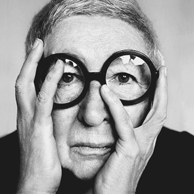Gae Aulenti
architect - designer (1927 - 2012)
Gae Aulenti, pseudonym of Gaetana Aulenti, was born in Palazzolo dello Stella (Udine) in 1927. Italian designer and architect particularly active in the field of architectural restoration and fittings.
He graduated in architecture at the Politecnico di Milano in 1954, and opened his private practice. Among the many professional activities practiced, Gae Aulenti undertakes architectural projects in various parts of Europe and the United States.
Among his most important works of architecture are: the transformation of the 19th century Gare d'Orsay in the Musée d'Orsay (1980-86, Paris, France), the design of the Musée National d'Art Moderne at the Center Pompidou (1982 -85, Paris, France), the design of Palazzo Grassi in (1985, Venice, Italy), the Museu Nacional d'Art de Catalunya (1985, Barcelona, ​​Spain), the direction of the restoration and transformation of the Scuderie Papali ( 1999, Rome, Italy), the Asian Art Museum of San Francisco (1997-2001, San Francisco, United States).
Takes part in the group of young people influenced by the thought of Ernesto Rogers works at the Casabella magazine from 1955 to 1965 as an art director.
Participate in the movement that will later be called Neo-art-nouveau or Neo Liberty, whose original components will appear in many of his works.
From 1960 to 1962 he taught at the University of Venice and from 1964 to 1967 at the Polytechnic of Milan.
In 1963 she began working as an industrial designer for the Zanotta company, with the creation of: April Stool (1963), April Chair (1963/1988), April Folding Chair (1964), Locus Solus Series (1965), Solus Chair (1965), Festo Table (1970), Work Table Gaetano (1971), Bettone Bed (1971), Bettino Bed (1972), Tripolina Chair (1973), Cardine Work Table (1983), San Marco Dining Table (1984), Appia Console (1984), Briscolo Gaming Table (1985), Office Series (1986).
In 1965 he designed the famous Pipistrello table lamp for Martinelli Luce.
In 1966 he worked with Olivetti for which he created showrooms including Olivetti Shop (1966, Paris, France). In 1968 he collaborated with the Fiat automobile factory, which he designed for exhibitions, commercial stands and showrooms. Among the shorooms are those in Zurich (1969-70, Zurich, Switzerland), Bruxel (1970, Brussels, Belgium), and Turin (1970, Turin, Italy).
In 1972 he took part in the famous Italian exhibition: the new Domestic Landscape organized by Emilio Ambasz at MoMa along with numerous other emerging designers and architects, including Marco Zanuso e Richard Sapper, Joe Colombo, Ettore Sottsass, Gaetano Pesce, Archizoom, Superstudio, Gruppo Strum e Gruppo 9999.
In 1974, Gae Aulenti designed his office and apartment in Milan, and in 1975 his country house near Assisi.
In 1985 he started working for iGuzzini Illuminazione creating a lighting system for Palazzo Grassi in Venice, the Cestello system, specifically designed as a lighting system for exhibitions, will be used in many of his museum construction works.
In 1992 he created the Italian Pavilion for the international Expo in Seville, in collaboration with Piero Castiglione and iGuzzini lighting technology.
His work, successfully shown in many performances, won numerous competitions.
After moving from the preparation of houses and showrooms to more important commitments, Gae Aulenti, like various other modern architects, works for a wide range of projects that, in addition to architecture, include industrial design and interior design.
He died on October 31, 2012 in Milan at the age of 84.
In 2012 the circular square located in the center of the Unicredit Tower complex in Milan was inaugurated and named.















